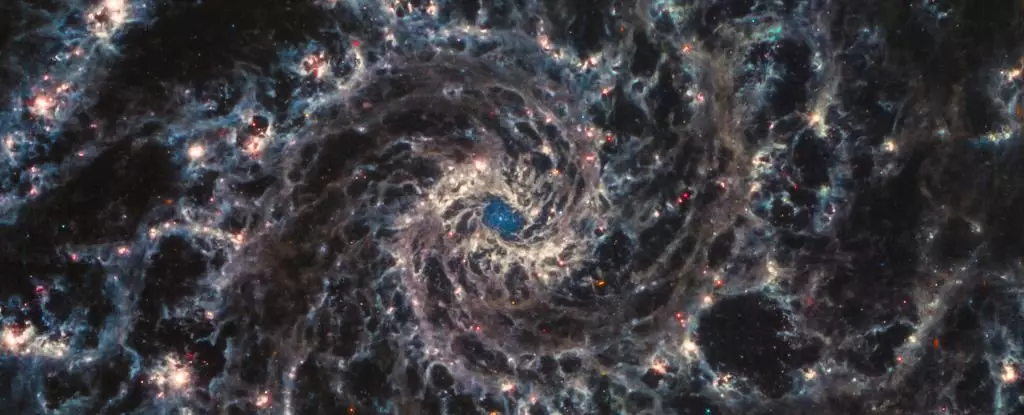The launch of the James Webb Space Telescope (JWST) three years ago marked a significant milestone in humanity’s quest to understand the universe. As the largest and most advanced space telescope ever constructed, the JWST was the result of 30 years of tireless research and engineering. In the relatively short span since its activation, this incredible instrument has already brought forth groundbreaking discoveries and illuminated the obscured corners of the cosmos, extending our comprehension of the early Universe and challenging existing astronomical theories.
With its irreplaceable position in space, beyond the interference of Earth’s atmosphere, the JWST utilizes infrared technology to observe celestial bodies in unprecedented detail. By capturing light from events that took place billions of years ago, it has unearthed some of the earliest galaxies formed when the Universe was just a mere 300 million years old—an incredibly brief period in cosmic history. Astonishingly, one of these ancient galaxies possesses a mass approximately 400 million times that of our Sun, leading researchers to conclude that star formation during this epoch was surprisingly efficient.
This revelation contradicts traditional models suggesting that early galaxies would be faint and dim, deterred by the gravitational challenges of youth. Instead, JWST has revealed that not only are these galaxies bright and massive, but they also appear exceptionally blue, lacking the expected dust that typically blurs our cosmic view. As scientists grapple with understanding the characteristics of these galaxies, they find themselves navigating a paradox: What accounts for this bright, dust-free appearance? Various hypotheses have emerged, including the possibility of massive stars collapsing without explosive deaths or overwhelming explosions that clear the dust from the galactic vicinity.
A New Look at Element Formation
Beyond the variables of galactic formation, JWST’s observations offer a fresh perspective on stellar chemical evolution. The telescope has uncovered surprising concentrations of nitrogen in ancient galaxies—significantly higher than levels found in our own Sun—while other heavy elements remain scarce. This anomaly suggests that our understanding of how stars forge elements in the cosmos is incomplete and that the early Universe adhered to different processes than we currently envision.
As the JWST continues its mission, it fundamentally challenges existing models and gaps in our knowledge, urging astronomers to reconsider what we think we know about the conditions that led to life as we recognize it today.
Utilizing gravitational lensing—a cosmic phenomenon where galaxy clusters magnify the light of distant objects—JWST has been able to discover an abundance of faint galaxies previously thought to be beyond reach. These faint structures have begun to emerge as crucial contributors to the end of the “cosmic dark ages,” a period after the Big Bang during which no light could penetrate the darkness of empty space. With findings that showcase the existence of galaxies emitting energetic light far exceeding predictions, JWST is forging a pathway to a more nuanced understanding of how and when galaxy formation ceased.
Moreover, the early images yielded by JWST unveiled puzzling cosmic phenomena known as “little red dots.” Initially theorized to be massive galaxies, further scrutiny has revealed they possess curious properties typical of rapidly rotating gas surrounding supermassive black holes—yet they lack usual signatures, like X-ray emissions. These “dots” open a tantalizing inquiry about the potential evolutionary relationship between stars and black holes during the Universe’s infancy.
In addition to discovering vibrant, active galaxies, JWST has also identified remnants of galaxies that no longer form stars—a shocking contrast to the turbulence of cosmic birth. These findings, albeit ancient, introduce a profound understanding of galactic life cycles. They offer valuable insights into structures that had been seen before but only now can be rigorously analyzed to discern their history and formation timelines.
Some of these early galaxies rival the mass of our Milky Way, raising essential questions about conventional theories of galaxy formation. Are current models adaptable, or do they require significant reconfiguration? This ongoing investigation challenges astronomers to rethink dark matter’s role and its influence on early cosmic development.
Even in its nascent stages, JWST has illuminated myriad shortcomings of prevailing cosmic theories. As researchers absorb the insights generated by its observations, they are left with thrilling prospects— the “unknown unknowns.” What additional wonders lie hidden in the vast cosmic expanse, waiting to be unveiled?
As the JWST continues its explorations, it holds the promise of reshaping our cosmic narrative and paving the way for new astronomical understandings, revealing not just the history of our Universe, but potentially the very origins of existence itself. It is indeed an epoch of discovery for humankind, as JWST will without a doubt push the boundaries of knowledge further than ever before.

